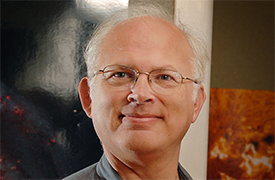
From the February 2018 Desktop News | A project led by an astronomer at The University of Alabama will use 12-25 minute gaps in the regular imaging schedule of the Hubble Space Telescope to get a better look at oddities found in the sky.
Dr. William C. Keel, a professor in the Department of Physics and Astronomy, led an effort to use Hubble to investigate unusual objects found by volunteer astronomers in a crowd-sourced astronomy project, Galaxy Zoo, and its companion Radio Galaxy Zoo.
Keel has long been involved with Galaxy Zoo and its offshoots, such as Radio Galaxy Zoo, to investigate oddities found by the volunteer astronomers. He assembled a team that includes scientists from other institutions and volunteers from three continents and proposed a list of more than 1,100 objects where Hubble exposure could give a better picture.
STScI informed Keel earlier this month that the proposal was selected for the gap program, but he needed to whittle the list to no more than 300 objects.
“This lets us potentially address a range of studies that happen very rarely to galaxies,” Keel said. “The volunteers, after filtering through a million galaxy images, have found a handful where there are weird things. We need the Hubble data to confirm this is happening. Each one of them might not be enough for an individual study, but when you put them all together it adds up to an interesting study.”
For this project, which Keel calls Gems of the Galaxy Zoos, objects includes oddities and rarities that could help in understanding how the universe formed and interacts with itself, such as extreme starbursts called green pea galaxies, spiral arms of a galaxy, and backlit dust structures, among other objects.
One example is an image of a merging pair of galaxies, catalogued as UGC 4052. It appears from ground-based telescopes to be forming a new disk of stars and gas around the remnant cores of both galaxies, which are normally violent events that make motions too chaotic for such a disk. If this happens often, it changes the understanding of the history of galaxies, Keel said.
Hubble data would clear the image to see if something in the background is playing tricks on the image, he said.
“What we study depends on what mix of galaxies Hubble is able to view,” Keel said. “Whenever a 20-minute schedule gap comes up, the software will go to the list to see what is closest.”
Hubble’s operators will schedule the objects in the gaps over the next few years, and the images will be publicly available as soon as they are captured. However, Keel and the science team will be notified when one of their images is viewed, allowing for further research.